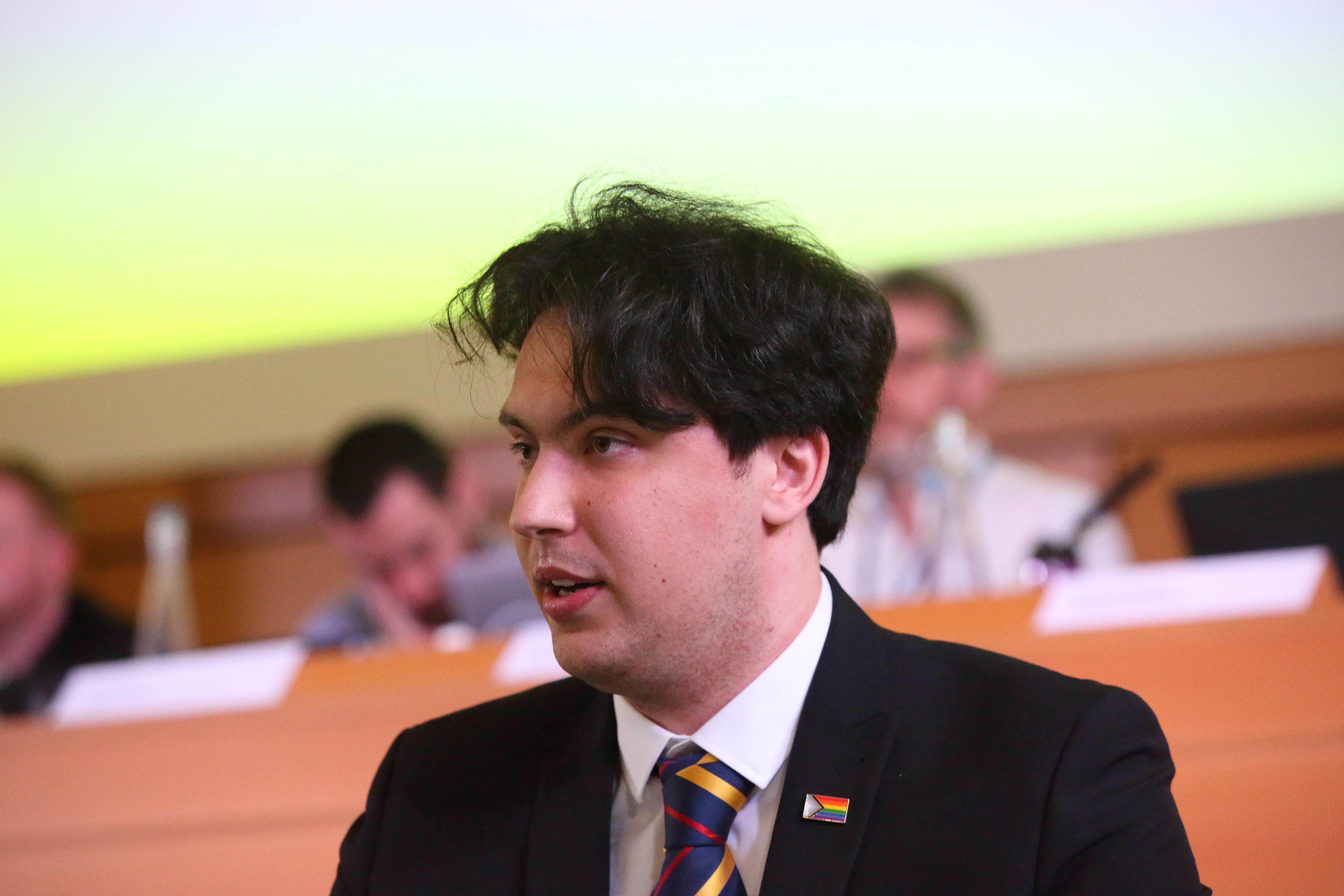If you’re reading this, congratulations! You are considering contributing to policy affecting doctors’ and medical students’ lives! It sounds a little bombastic, but I can assure you that what you submit to a conference could very well be at the spearhead of the BMA’s national or local campaigning.
I want to share my experiences as someone lucky enough to have this happen to me.
Your path to conference
 Louis Davenport
Louis Davenport
My journey started with reading an ad from my local rep about the BMA’s medical students conference in our medical society’s newsletter. I was interested in healthcare policy but hadn’t considered a BMA conference as an outlet for it. But, the message from our rep made me change my thinking. I might as well give it a go!
You path to writing a motion for the conference might be different – but if you’re reading this then you’re already on it! Get in contact with your local MSC (medical students committee) rep and see what the current status is of your medical school’s motions. More than likely they will be delighted to have more students involved! They can point you in the right direction and explain the process.
Creating your motion
What do you care about in healthcare? Seriously, think about it for a moment.
Do you care about activism in healthcare? Education about a specific condition that’s close to your heart? Migrant healthcare provision shortfalls? UK overseas development aid spending? What would you change if you could snap your fingers and change it?
You don’t need to be an absolute expert on current policy around the topic. If your motion is taken forward as part of action by the executive committee, the BMA will draw on expert policy advisors to help work out the details of what actions need to be taken.
I’d been involved in a local campaign surrounding the GLADD UK Medical Schools LGBTQ ‘Conversion Therapy’ Charter, so I decided to write about that.
Once you have a topic, it’s just a matter of shaping your motion so that it calls for the change you would like to see. Here, the details are important, so let’s go over two points:
First, there is a limit of 250 words. You need to keep it short and sweet. It may help to remember that this is a directive statement – which is to say that it tells people what to do, not necessarily how to do it. Details can be compelling in putting your point across, as can concrete examples of solutions. However, if you are struggling for space, focus on the outcome you want to achieve rather than the process.
Secondly, you can think of a motion as taking two different parts that are structured separately. The first part is a short explanatory statement. If you want to deploy some short facts and figures to enhance your written rhetoric, do so here. Then, start a separate paragraph with ‘This conference calls for X’ where X is the result you want. You could also name wider organisations that may be useful in achieving these goals (but get advice on how to name organisations in a non-defamatory manner).
We have past policy books (such as from 2024-2025) that you can look at for examples of previously adopted motions – and a dedicated page for searching medical student motions, so you can compare and make sure your motion is in tip-top shape. There is also detailed motion writing advice.
At conference
It can be nerve-wracking to have your motion picked to go to conference! Especially if, like me, it was your first time even going to a BMA conference. It helps to know what’s going to happen there, so I’ll briefly explain.
If yours is one of the top three motions in your medical school, it gets put forward to the conference agenda committee via your rep. They’ll sort it into one of three lists:
-
White motions are traditionally voted on and debated on the conference floor. If you want the ‘traditional’ conference treatment of your motion, this is the list you’re aiming for!
-
‘A’ motions are debated and voted on in a large block at the start of the conference. Objections can be raised, but these are usually motions that are uncontroversial or reflects policy that already exists. You can check if an area of work has already become MSC policy by visiting the policies database.
-
Grey motions are those judged to be less relevant or poorly written. However, that doesn’t mean it’s the end of your motion! A small proportion are voted to be put forward to be debated as white motions. These are voted on by people during the conference and it falls to the chair to decide whether there is time to look at them.
Other things can happen to your motion during the conference, such as it being split up into ‘parts’, or being voted for in spirit but not in concrete policy. This should be explained further at the conference.
You’ll be surprised how quickly it can go from getting up to present your case to getting your motion passed by the conference! I was lucky enough to get mine onto the slate of white motions and after a brisk debate, the conference passed the motion.
What happens to my motion after it passes?
First off, pat yourself on the back – you’ve helped write national policy!
Your motion could also be selected by the agenda committee to go to the ARM (annual representative meeting). Be sure to nominate yourself for one of the 29 ARM seats the conference receives, the election for which also takes place over the conference days.
You could also get in contact with the medical students committee via your local rep and see if they can bring it to their attention for action.
The BMA is flexible on how we implement policy as it often applies to different contexts or people. Crucially, as your reps are elected, it is important to keep us accountable so follow up and make sure we are actioning what matters to you!
As for me? Well, I am proud to say that my motion is currently the impetus for a continued push by the BMA to have medical schools sign the GLADD charter (read more below).
I wish you luck in having your motion enact the change you want to see!
Louis Davenport (he/him) is a medical student and BMA representative for Bristol Medical School
Our progress on the ‘conversion therapy’ charter
 Ria Bansal and Akshata Valsangkar
Ria Bansal and Akshata Valsangkar
After Louis’s motion passed in 2022, the MSC has worked alongside GLADD to encourage all medical schools in the UK to sign the GLADD medical schools charter. As of December 2024, we’ve helped get 40 out of 46 medical schools as signatories. With six medical schools left, our attention has narrowed onto them – encouraging them to open a dialogue with us, with the hope to campaign and urge them to sign!
Our work doesn’t end here. The MSC is dedicated to promoting LGBTQ+ equality and student welfare further. Our agenda over the next year includes due diligence to see if medical schools are meeting the promises they made in signing the charter. We also want to make sure that in the midst of activism and the fight for equality, LGBTQ+ medical students are supported and equipped to thrive throughout medical school.
Conference sets the direction for our committee’s work. As the welfare chairs, Louis’s motion highlighted our priorities and advanced our work to support LGBTQ+ medical students.
Ria Bansal, a medical student at the University of Nottingham, and Akshata Valsangkar, a medical student at the University of Bristol, are the BMA medical students committee deputy co-chairs for welfare

